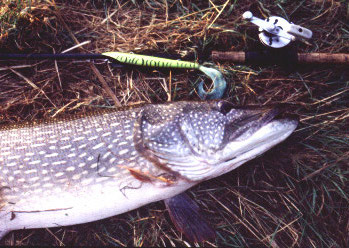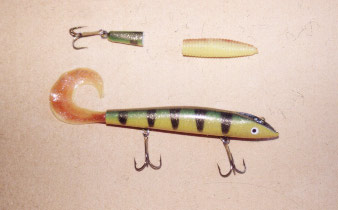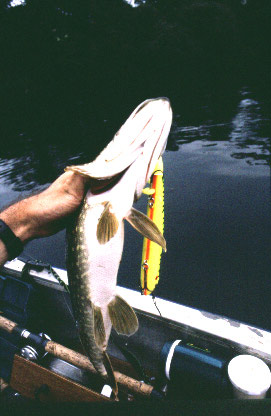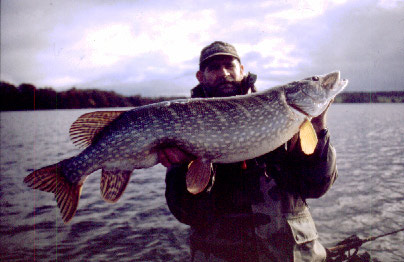 Ever
since I got my hands on my first sample Burts I have been catching fish on them,
from all sorts of waters (fourteen or fifteen in total) and in just about every
month of the year. Pike of all sizes have fallen for their unique charms, from
small jacks up to twenty pounders. I have also netted a few fish for my mate,
Nige Grassby, on the Burt (after I had convinced him that they could catch pike),
including a thirty-three and a twenty-seven in one day, my best Burt-caught brace
being a twenty-two and a twenty-eight. To say that Nige and I have confidence
in this lure is an understatement! Despite this I still speak to people
who can't catch on the Burt. So here I hope to pass on some of my tips, which
might just give the sceptics a bit more confidence in the lure.
Ever
since I got my hands on my first sample Burts I have been catching fish on them,
from all sorts of waters (fourteen or fifteen in total) and in just about every
month of the year. Pike of all sizes have fallen for their unique charms, from
small jacks up to twenty pounders. I have also netted a few fish for my mate,
Nige Grassby, on the Burt (after I had convinced him that they could catch pike),
including a thirty-three and a twenty-seven in one day, my best Burt-caught brace
being a twenty-two and a twenty-eight. To say that Nige and I have confidence
in this lure is an understatement! Despite this I still speak to people
who can't catch on the Burt. So here I hope to pass on some of my tips, which
might just give the sceptics a bit more confidence in the lure.A
couple of practical advantages to the Burt are that it comes through the water
easily and doesn't weigh a ton, so it is not as tiring to fish as some jerkbaits.
You can toss a Burt all day long without getting fatigued. Well, not too fatigued!
That alone is not reason enough to fish a lure, there has to be more to it than
laziness. The action must play some part in its success. Too many people are hung
up on using lures that have an obvious action. Wiggling crank baits, wide gliding
jerkbaits or rod-throbbing spinnerbaits. It is the lack of an obvious action that
puts people off the Burt, and reduces their confidence in the lure before they
start fishing it. Pike think differently.
Take
a Burt, any Burt, out of the box, sharpen the hooks and you are almost ready to
roll. First thing to do is fit a split ring to the line tie. Whether this makes
the lure work any better I can't say for sure, but it seems to help it swing.
That is the key to the action of the Burt. It is not a glidebait with a regular
side-to-side action, and it is not a chopbait like the Suick. It is what I term
a swingbait, there is a little forward motion before the lure veers off to one
side. In actual fact, if you alter the way you fish the Burt you can get different
actions out of it. Play around to get a feel for the lure. For maximum swing it
needs a long, fairly slow, sweeping stroke of the rod tip, from straight in front
of you to a point where the rod has moved through 45 degrees or maybe even more.
Give it rapid short jerks and the swing is much reduced. These rules apply to
both floating and weighted Burts. The weighted models have much less inherent
swing than the floaters, no matter what you do. It's the nature of the beast.
If
you have a Burt that swings more to one side than the other there are two lines
of attack. One is not to worry about it, odds on it'll still catch. The other
is to pare away one side of the scoop at the head of the lure. Following the instructions
provided with the lure, tiny step by tiny step, will usually sort the problem.
Shave some of the plastic from the opposite side of the scoop to the direction
in which the lure is running. Check the action after each scrape is made. Bending
the line tie slightly to one side or the other can also do the job.
With
both models, and with the Squirlley Burts which I will deal with later, there
is a tendency for the middle hook (rear hook on the Squirlley) to foul on the
top of the body. This messes up the action and probably affects hooking potential.
The answer is simple. Remove the hook and push its eye through a disc cut from
the body of a large grub. The disc should be 3-4mm thick. Replace the hook
and this 'bumper' prevents it fouling the lure, yet doesn1t impede hooking.
Over
the years Burts have come fitted with many different patterns of treble. For replacements
I always use 4/0 Eagle Claws in the 974 pattern. Although I have been impressed
with some wide gape round bends in a medium wire that were fitted to a few of
my early Burts. That little bit of extra width seems good. However, as Burts are
moulded from hard plastic they are pretty good hookers, sliding through pike's
teeth until a hook takes hold. You do miss a few, but not enough to worry about.
I find that most fish are hooked on the front treble, but I have landed enough
pike which have been looked on the other trebles to leave all three on the straight
Burt! It might be the fish you really want that grabs the lure at the back end!
Because
Burts are injection moulded, with (I think) seven body cavities, they can be quite
easily modified. The most obvious alteration is the conversion to a Squirlley
Burt. One of the first samples Pete Maina sent me was a pre-production model in
an appalling pattern (white with a red throat and blue, green and gold on the
back). I had no confidence in it to start with, but still caught a couple of jacks
on it within an hour of trying it out. This floating model still produces fish
for me under the right conditions, and has become one of my banker baits. It started
life with a silver glitter tail, but has now gone through a few white ones in
its time, and has even caught when the tail was removed!
 If you
have no Squirllies it is a piece of cake to convert a straight Burt. Take a hacksaw
and cut off the back end of the bait. Make the cut at the 'i' in the word 'Mania'
embossed near the tail end. Pare away the rough edges, and if necessary, seal
up the bottom of the exposed cavity with a little Araldite or five minute epoxy.
Then take a large grub, six or eight inches, with a body that will be a tight
squeeze in the cavity. Cut the grub so as to leave just enough body to push in
to the Burt. Push it in so that the tail curls upwards and is lined up with the
seam on the top of the lure. (A mate of mine fits his tails the other way up,
which he reckons gives the lure more stability. Take your pick.) Then push the
nozzle of a superglue tube between the grub tail and the hard plastic of the Burt
and run the glue around the grub. Leave it to dry and away you go. In dire straits
one day when the tail of one Squirlley started to fall out, and with a lack of
superglue in the boat, I held the tail in place with an Elastoplast wrapped around
the back end of the lure... and caught a couple of small fish before the plaster
fell off.
If you
have no Squirllies it is a piece of cake to convert a straight Burt. Take a hacksaw
and cut off the back end of the bait. Make the cut at the 'i' in the word 'Mania'
embossed near the tail end. Pare away the rough edges, and if necessary, seal
up the bottom of the exposed cavity with a little Araldite or five minute epoxy.
Then take a large grub, six or eight inches, with a body that will be a tight
squeeze in the cavity. Cut the grub so as to leave just enough body to push in
to the Burt. Push it in so that the tail curls upwards and is lined up with the
seam on the top of the lure. (A mate of mine fits his tails the other way up,
which he reckons gives the lure more stability. Take your pick.) Then push the
nozzle of a superglue tube between the grub tail and the hard plastic of the Burt
and run the glue around the grub. Leave it to dry and away you go. In dire straits
one day when the tail of one Squirlley started to fall out, and with a lack of
superglue in the boat, I held the tail in place with an Elastoplast wrapped around
the back end of the lure... and caught a couple of small fish before the plaster
fell off.
An added attraction
with the Squirlley is that the tail continues to move a little when the lure is
paused. If this is a trigger I cannot say, but it looks good to me! Floating Squirllies
can be used as dead slow surface crawlers in the summer. Dragging the bait along
so its lip never breaks surface, but so the tail wriggles along. I have only had
a couple of fish doing this, but it is worth bearing in mind. Another summertime
trick with the floaters is to use them a bit like a popper. Let them settle, then
rip them hard and pause so they dive and bob back to the top. Get the wrist action
right and quite a commotion can be created. Sometimes it is worth ripping them
again just before they break surface for a slightly more subtle presentation.
 One thing
that makes a big difference when fishing the Burt, any model, is the pause between
pulls, rips or jerks. This is when most takes will come. Even super-buoyant floaters
get hit on the pause. By giving a floater a few short sharp jerks at the start
of the retrieve you will maximise its diving depth. Once you have got it down
ease up. Slow and lengthen the pulls and extend the pauses. Always break up the
rhythm. Two pulls a pause, two pulls a pause, one pull a pause, three pulls a
pause. Ring those changes. Too regular an action will be more likely to alarm
a pike than something erratic.
One thing
that makes a big difference when fishing the Burt, any model, is the pause between
pulls, rips or jerks. This is when most takes will come. Even super-buoyant floaters
get hit on the pause. By giving a floater a few short sharp jerks at the start
of the retrieve you will maximise its diving depth. Once you have got it down
ease up. Slow and lengthen the pulls and extend the pauses. Always break up the
rhythm. Two pulls a pause, two pulls a pause, one pull a pause, three pulls a
pause. Ring those changes. Too regular an action will be more likely to alarm
a pike than something erratic.
Floating
Burts work in the top four feet of the water column. Because they back up on the
pause, with a bit of a wobble, they are good for working over the top of weeds.
Dive them down to the weed and let them float back up. They can actually
be fished through some sorts of weed, and here Squirlley models are best as they
lack the tail treble that so often fouls the weed. The angle at which a
floater works also seems to keep the hooks clear.
When
fishing deeper water, or when the pike are less willing to come up for a lure,
select a weighted Burt. The standard ones will run down to nine feet on a good
day. There is some variation between individual Weighted Burts, despite their
plastic construction. I have examples of them with different numbers of bullets
in them! (With light coloured Burts you can inspect their insides by holding the
lure up to a bright light bulb.) So their buoyancy is bound to be different. As
a rule a Weighted Burt is good for six feet or a little more, depending on the
weight of your leader and thickness of your line.
For
fishing from a drifting boat the Burt is hard to beat. Gliders can be troublesome
to fish effectively when cast across the wind. Burts aren't. You need less concentration
to fish a Burt effectively than retrieve-critical gliders like Odyssey Pigs. Again
the few quick jerks at the start of the retrieve will help get the bait down,
but I tend to work Weighted Burts with longer slower pulls than I do the floaters.
This seems to make them fish deeper better. Longer pauses can be thrown in with
these baits too. So for later in the year the weighted model is the one to go
for. Some suspend on the pause, some rise slowly and one or two sink slowly. A
sinking Burt can be a real killer!
It
is easy enough to make a Burt sink. Although adding weight in the traditional
manner, using vegetable oil, adds weight it does level out inside the lure the
cavities are not always oil-tight. My trials with oil were not too successful.
I have had more success by adding shot to the various body cavities. Distributing
it more towards the head, with some counterbalast at the back end, more of the
bait's swing can be maintained. Experimentation is crucial. One of my early
attempts, in which the weight was distributed evenly, created a lure that sank
but which rolled on its back and came up to the top when I worked it!
To
doctor a Burt I drill holes in the belly of the lure and trickle lead shot inside.
For testing purposes I seal the holes using hot melt glue sold for quick tip ring
fixes. Smear some molten glue over the hole and chuck the lure in a tank of water
to check its sink rate, or better still have a cast or two with it to check out
the action too. If it works you can then seal the holes more permanently with
epoxy if you wish. Sinking Squirllies have been known to get taken on the drop!
Fish sinkers even more slowly than the standard weighted Burt.
 Although
the Burt is primarily a jerkbait, albeit a versatile one, it can also be used
for trolling. Both straight and Squirlley versions will catch on the troll. Crank
a Burt straight in and you will see that it snakes from side to side. I am sure
that there will be a time when that retrieve is going to be successful too. When
trolling Burts (or any other jerkbait for that matter) it is best to hold the
rod so that you can draw the rod tip forward and hold it there for a few yards,
then drop it back and, effectively, throw in that good old pause which triggers
so many strikes. Breaking up the regular snaking of the lure's path is always
a good idea.
Although
the Burt is primarily a jerkbait, albeit a versatile one, it can also be used
for trolling. Both straight and Squirlley versions will catch on the troll. Crank
a Burt straight in and you will see that it snakes from side to side. I am sure
that there will be a time when that retrieve is going to be successful too. When
trolling Burts (or any other jerkbait for that matter) it is best to hold the
rod so that you can draw the rod tip forward and hold it there for a few yards,
then drop it back and, effectively, throw in that good old pause which triggers
so many strikes. Breaking up the regular snaking of the lure's path is always
a good idea.
So,
after all that, what makes the Burt so good? I think it is their versatility and
adaptability. Kit yourself out with a few variations and you are equipped to catch
pike in all sorts of places. Burts have worked for me on rivers, drains canals,
reservoirs, big lakes, small lakes, trout waters, lochs..... You name it. They
have caught shallow and deeper, from bank and boat. Worked fast and slow,
summer and winter. Even so, there will be some of you who have read this
far and remain unconvinced. All I can say in closing is that I rarely venture
out lure fishing without at least one Burt of some description in my lure box.
(This
article first appeared in Lure Angler - Autumn 2001)

